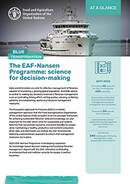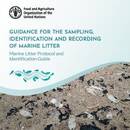EAF-Nansen Programme Communication material

The EAF-Nansen Programme helped establish dedicated "Gender Desk" within the Fisheries Ministries in Tanzania and The Gambia from 2022 to 2023, to mainstream gender in all activities of the institutions’ work within the national fisheries sector. The experience showed that there are different levels of awareness and consideration of gender issues to be taken into account, and that there is a need to build institutional capacity on gender mainstreaming. A “Gender Desk” also needs to be a multi-sectoral and multi-level intervention focused on replicability and partnership, to succeed.This document summarizes the lessons learned from the collaborative effort that involved colleagues from the EAF-Nansen Programme, and various gender units in the Food and AgricultureOrganization of the United Nations (FAO) and the Fisheries and Aquaculture Division (NFISG), both at the Regional Office for Africa and in Headquarters. Experts from other relevant FAO teams and UN Women were also identified to lead specific aspects. The target audience for this document is the collection of beneficiaries and sectoral institutions of the EAF-Nansen Programme working in the fisheries sector. This fact sheet is also intended to serve as a guide and/or model for partner countries that are yet to establish fisheries gender desks.

The EAF-Nansen Programme, a collaboration between the Food and Agriculture Organization of the United Nations (FAO), Norway, and various regional and national partners, promotes sustainable fisheries management through scientific research and data collection. Since 1975, the Programme has employed the research vessel Dr. Fridtjof Nansen to gather unique data on marine resources and ecosystems, contributing to the monitoring and assessment of fisheries while addressing global challenges like biodiversity conservation and climate change. Between 2017 and 2023, the EAF-Nansen Programme conducted 62 research surveys involving over 650 scientists, discovered 24 new species, and developed science-based fisheries management plans benefiting nine countries. The state-of-the-art Dr. Fridtjof Nansen research vessel not only gathers data but also serves as a training platform for researchers and early-career scientists. From 2017 to 2023, the Programme trained over 800 individuals in fisheries management, stock assessment, and research, significantly enhancing the capabilities of partner countries. The Programme's extensive data collections from marine areas worldwide are accessible to member countries and stakeholders through an online metadata portal. Moving forward, from 2024 to 2028, the EAF-Nansen Programme will intensify efforts to improve food and nutrition security, with a strong focus on adapting fisheries management to the impacts of climate change.

Marine litter, especially marine plastic litter, is becoming more abundant in the ocean, and is having an increasing impact on human health, livelihoods and the environment. To reduce the amount of litter entering the ocean, and reduce the social, economic and environmental impact, society will need to adopt measures to reduce the generation of waste and improve waste management. Providing evidence of the distribution and abundance of marine litter, the location of litter ‘hotspots’, and the proportion of the various categories of litter, will help in the design and implementation of management measures to reduce the leakage of litter to the ocean.These guidelines have been developed for use by researchers in EAF-Nansen Programme Partner Countries to assist them in sampling, identifying and recording marine litter, to a consistent standard.

Urgent action is needed to reduce the leakage of plastics to the ocean. To do this we need more information on the quantities and types of litter that have leaked, especially from regions and countries where data are scarce or lacking. With more knowledge, we will also be able to estimate the risk to local fishing communities in terms of social health well-being and economic resilience. In addition, we will be better placed to assess the impact of litter on key maritime sectors, such as fisheries, as well as on key environmental indicators such as breeding grounds and sensitive habits.
The EAF-Nansen Programme has been running two studies on marine litter. The first study involved the recording of the litter retrieved in the demersal trawl, during surveys with the research vessel (R/V) Dr. Fridtjof Nansen, in the period 2011–2023. The second study examined the impact of marine litter on the beach seine fishery of four countries in the Gulf of Guinea.
The EAF-Nansen Programme is a longstanding partnership between the Food and Agriculture Organization of the United Nations (FAO) and Norway, dating back to 1975. It is executed by FAO in close collaboration with the Institute of Marine Research in Norway (IMR), and funded by the Norwegian Agency for Development Cooperation (Norad).

The second evaluation of the small and medium pelagic fishery in the United Republic of Tanzania was carried out in November 2021, by a group of multidisciplinary experts, including fisheries managers, scientists and fishers. The first evaluation was carried out almost two years after the first benchmark scoring of the fishery, conducted in January 2020, shortly after the start of the project to support the implementation of the small and medium pelagic management plan in the country. The aim was to assess the progress made since the last scoring. The ecosystem approach to fisheries implementation monitoring tool (EAF IMT) was developed to allow the monitoring of the progress of the EAF implementation and sustainable fisheries management. It allows the implementation of the EAF to be evaluated at different levels: at the level of a particular issue, to the level of EAF component, up to the entire fishery level.
